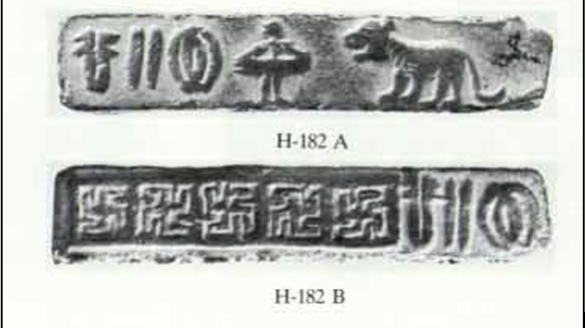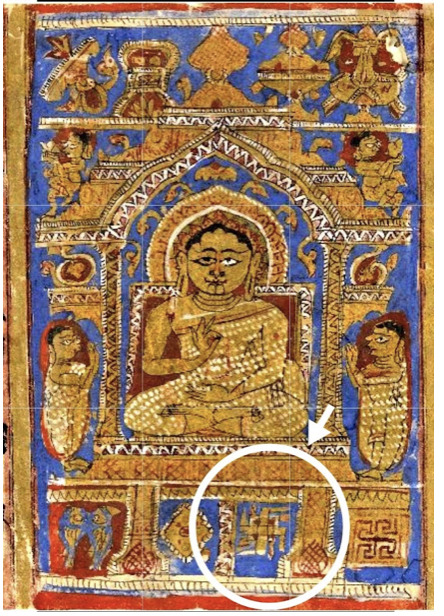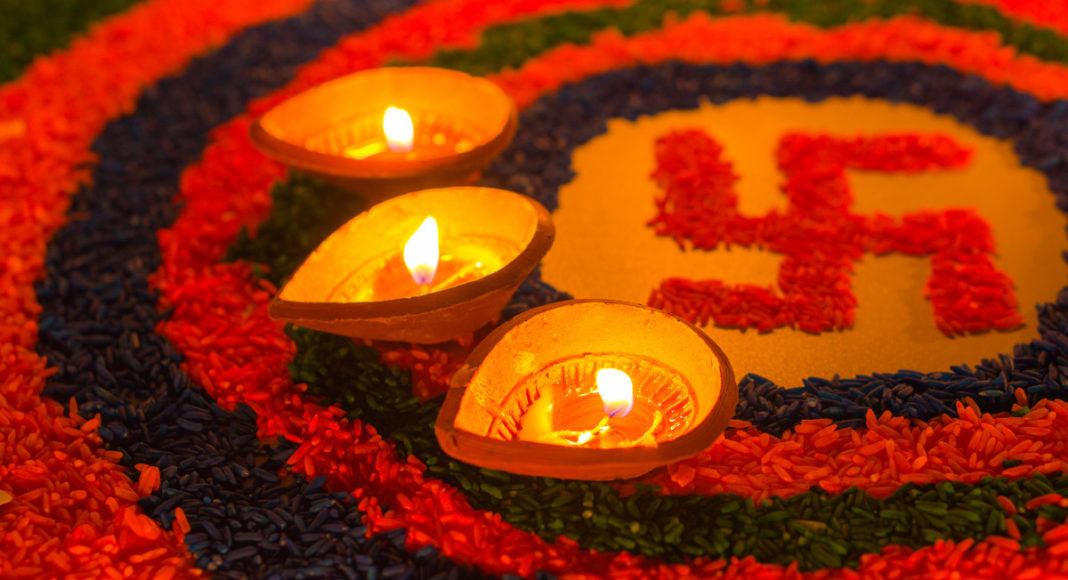The swastika is an Indian symbol of peace and auspiciousness that Hitler hijacked for his preposterous Nazi superiority concept. The swastika is far older, dating back to the Indus Valley Civilization (3rd Millennium BCE), i.e., even before the Vedic Aryan Age, in the Indian Subcontinent.
Unfortunately, whenever this issue comes up, the horrors of Hitler’s hijacking of Swastika to fit his Nazi supremacy generally take centre stage.

Figure 1: A Visual Comparison of the Indian Swastika and the Nazi Hakenkreuz.
Those who know Swastika only as Nazi Hakenkreuz (Hooked Cross) may be surprised to learn that Swastika is one of the oldest, most widely distributed religious symbols in the world.
Swastika-like forms appear on Palaeolithic carvings on mammoth ivory from Ukraine, dated circa 10,000 BCE. This symbol also figures in the oldest coinage in India. Persia, Asia Minor, and Greece represented the rotating axis Mundi with the symbol of a Swastika.
On a Boeotian amphora of the 7th century BCE, it was presented as a sacred sign of the Goddess Artemis. It also represented many other deities from Iceland to Japan and Scandinavia to North Africa. It was much used in Troy and Mycenae before the 13th century BCE (Walker, 1983, p. 964).
The symbol of Swastika is found engraved in the steatite seals of Harappa, Mohenjo-Daro, and Lothal, this is the earliest occurrence of the symbol of Swastika in India. This along with other symbols is also found on the earliest currency of India viz., the punch-marked coins (Ramachandran, 1960, p. 81).
The word ‘Swasti’ is frequently used in Vedic hymns to represent blessings, benedictions, success, fortune, and other things. ‘Su’ means “good or well” in Sanskrit, and ‘asti’ means “to be,” therefore ‘Swasti’ indicates well-being. The suffix ‘ka’ (Swasti+ka) emphasises the word sense, thus ‘Swastika’ literally means ‘that which is associated with well-being.’

Figure 2: Indus Valley Tablet (shown with both the faces H-182 A and H-182 B) excavated from Harappa. One of the faces shows five Swastikas in a row. The image is taken from Joshi and Parpola (1987).
In the preface to the second reprint of the ‘Report on the Old Records of the India Office’ (London, 1891), Sir George Birdwood gives an explanation of the ritualistic significance of the Swastika as manifested in Hindu symbolism. He says that the “right-hand Swastika is, among modern Hindus, a symbol of Ganesha, and is commonly placed by them, instead of the image of Ganesha at the head of the invoices and other papers.”
It is also the symbol of the Sun in his diurnal course from east to west, and it is coloured red, the proper colour of the East. The left-hand Swastika is the symbol of Kali, the mother of Ganesha, and of the Sun in his nocturnal course from west to east, and is coloured blue. The right and left-hand forms are spoken of as “reversely revolving Swastikas” (Willey, 1910, p. 183).
The sign of the Swastika is reported in great number in the inscriptions on the rock walls of the Buddhist caves in India. They are the same size as the letters forming the inscription; that they all have four arms and the ends turn at right angles, or nearly, so, indifferently to the right or to the left (Wilson, 1896, p. 805).
The list of inscriptions, containing the Swastikas, has been listed by Wilson (1896) in the book: “Report of Dr. James Burgess on the Buddhist Cave Temples and their Inscriptions,” being a part of the result of the fourth, fifth, and sixth Seasons’ operations of the Archaeological Survey of Western India: 1876, 1877, 1878, 1879. Eugène Burnouf says approvingly of the Swastika: “Christian archaeologists believe this was the most ancient sign of the cross. It was used among the Brahmins from all antiquity. Swastika in India corresponds to benediction among Christians” (Wilson, 1896, p. 802).
In Japan, the reborn Amida, “Buddha of Immeasurable Light,” wore a left-handed Swastika carved on his chest. A similar left-handed Swastika was the sign of Thor’s hammer on Scandinavian coins. Sanskrit meaning Swastika literally meant “so be it” or “amen.” In Japan, the Swastika was an ideogram for “infinity” – the number 10,000, which was a synonym for infinity because it was the highest number Japanese sages could visualise (Walker, 1983, p. 964-965).

Figure 3: Illustration from a Jain Kalpasutra Manuscript, late 15th century. It shows Jain Swastika symbol (marked above) in the bottom layer, which is one of the eight auspicious symbols (Ashtamangalas) in Jainism (Brooklyn Museum, 2010).
Mr. Virchand R. Gandhi, a Hindu and Jain disciple from Bombay, a delegate to the World’s Parliament of Religions at Chicago in 1893, explains the Jain Swastika as follows:
“The horizontal and vertical lines crossing each other at right angles from the Greek cross. They represent spirit and matter. We add four other lines by bending to the right of each arm of the cross…
The idea thus symbolized is that there are four grades of the existence of souls in the material universe.
The first is the lowest state—Archaic or protoplasmic life. The soul evolves from that state to the next—the earth with its plant and animal life.
Then follows the third stage—the human; then the fourth stage—the celestial.
The word ‘celestial’ is here held to mean life in other worlds than our own.
All these graduations are combinations of matter and soul on different scales. The spiritual plane is that in which the soul is entirely freed from the bonds of matter.
In order to reach that plane, one must strive to possess the three jewels (represented by the three circles), right belief, right knowledge, right conduct”
(Wilson, 1896, p. 804).
Despite its current problematic connotations deriving from its abuse as a Nazi emblem, it is clear from the above analysis that the Swastika symbol holds the highest spiritual significance for Hindus, Buddhists, and Jains.
It is a ‘living’ symbol of auspiciousness in the Indian Subcontinent.
The existence of Swastika may be traced back to the dawn of civilisation in this region, and its direct and modified variants are still frequently used to this day.
It may be found in practically every aspect of life, including religious rituals, art, architecture, coinage and seals, textiles, and wall decorations, of Indians as well as Indian Diaspora throughout the globe.
Authors:
Yadu Singh is a Sydney-based Cardiologist who has a keen interest in Indian History.
Vikrant Parmar is Electrical Engineer with a strong interest in Indian Medieval History.
Disclaimer: The author is solely responsible for the views expressed in this article. The opinions and facts are presented solely by him, and neither The Australia Today News nor its partners assume any responsibility for them.
References:
- Walker, B.G. (1983). The Woman’s encyclopaedia of Myths and Secrets. Harper & Row, San Francisco.
- Ramachandran, K.S. (1960). Swastika as a decorative Motif of Indian Pottery: A Short Note. Proceedings of the Indian History Congress, Vol. 23, Part-I, 81-83.
- Willey, A. (1910). Swastika and Udakiya in Ceylon. Man Vol. 10, 183-185.
- Wilson, T. (1896). The Swastika: The Earliest Known Symbol, and Its Migrations; With Observations on the Migration of Certain Industries in Prehistoric. From the Report of the U. S. National Museum for 1894, 757-1011.
- Joshi, J.P., & Parpola, A. (1987). Corpus of Indus Seals and Inscriptions: Memoirs of the Archaeological Survey of India Number 86. Suomalainen Tiedeakatemia.
- Brooklyn Museum (2010). Illustration from a Jain Kalpasutra Manuscript, late 15th century; Opaque watercolor and gold on paper [Painting]. Brooklyn Museum, New York City, New York. https://www.brooklynmuseum.org/opencollection/objects/46263




